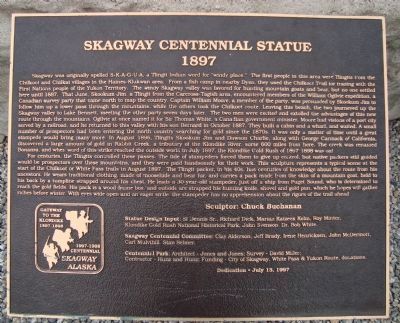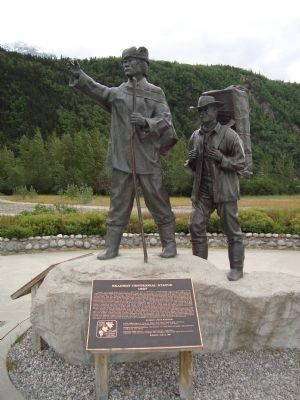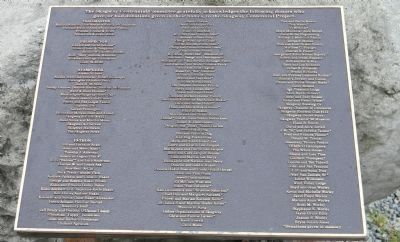Skagway, Alaska — Northwest (North America)
Skagway Centennial Statue
1897
Skagway was originally spelled S-K-A-G-U-A, a Tlingit Indian word for “windy place.” The first people in the area were Tlingits from the Chilkoot and Chilkat villages in the Haines-Klukwan area. From a fish camp in nearby Dyea, they used the Chilloot Trail for trading with the First Nations people of the Yukon Territory. The windy Skagway valley was favored for hunting mountain goats and bear, but no one settled here until 1887. That June, Skookum Jim, a Tlingit from the Carcross-Tagish area, encountered members fo the William Ogilvie expedition, a Canadian survey party that came north to map the country. Captain William Moore, a member of the party, was persuaded by Skookum Jim to follow him up a lower pass through the mountains, while the others took the Chilkoot route. Leaving this beach, the two journeyed up the Skagway valley to Lake Bennett, meeting the other party seven days later. The two men were excited and extolled the advantage of this new route through the mountains. Ogilvie at once named it for Sir Thomas White, a Canadian government minister. Moore had visions of a port city served by a railroad, and returned to this valley with his son Bernard in October 1887. They built a cabin and a wharf, and waited. A small number of prospectors had been entering the north country searching for gold since the 1870’s. It was only a matter of time until a great stampede would bring many more. In August 1896, Tlingits Skookum Jim and Dawson Charlie, along with George Carmack of California, discovered a large amount of gold in Rabbit Creek, a tributary of the Klondike River, some 600 miles from here. The creek was renamed Bonanza, and when word of this strike reached the outside world in July 1897, the Klondike Gold Rush of 1897-1898 was on!
For centuries, the Tlingits controlled these passes. The tide of stampeders forced them to give up control, but native packers still guided would-be prospectors over these mountains, and they were paid handsomely for their work. This sculpture represents a typical scene at the start of the Chilkoot or White Pass trails in August 1897. The Tlingit packer, in his 40’s, has centuries of knowledge about the route from his ancestors. He wears traditional clothing, made of moosehide and bear fur, and carries a pack made from the skin of a mountain goat, held to his back by a tumpline strapped around his chest. He leads a 30 year-old stampeder, just off a ship from Puget Sound, who is determined to reach the gold fields. His pack is a wood-frame box, and outside are strapped his hunting knife, shovel and gold pan, which he hopes will gather riches before winter. With eyes wide open and an eager smile, the stampeder has no apprehension about the rigors of the trail ahead.
Statue Design Input: Si Dennis Sr., Richard Dick, Marian Katzeek Kelm, Roy Minter, Klondike Gold Rush National Historical Park, John Svenson, Dr. Bob White.
Skagway Centennial Committee: Clay Alderson, Jeff Brady, Irene Henricksen, John McDermott, Carl Mulvihill, Stan Selmer.
Centennial Park Architect – Jones and Jones; Survey – David Miller; Contractor – Hunz and Hunz; Funding – City of Skagway, White Pass & Yukon Route, donations.
Erected 1997 by Skagway Centennial Committee.
Topics. This historical marker is listed in these topic lists: Exploration • Native Americans. A significant historical month for this entry is July 1897.
Location. 59° 27.177′ N, 135° 19.169′ W. Marker is in Skagway, Alaska. Marker is on Broadway, on the right when traveling north. The Skagway Centennial Statue is located in Skagway Centennnial Park. Touch for map. Marker is at or near this postal address: 157 Broadway, Skagway AK 99840, United States of America. Touch for directions.
Other nearby markers. At least 8 other markers are within walking distance of this marker. Three Thousand Pack Animals (here, next to this marker); Skagway and White Pass (a few steps from this marker); Inspector Charles Constantine (within shouting distance of this marker); Jeff. Smith’s Parlor (about
400 feet away, measured in a direct line); Fatal Duel (about 500 feet away); Arctic Brotherhood Camp Skagway (about 500 feet away); Captain William Moore (approx. ¼ mile away); Skagway's Historic Waterfront (approx. ¼ mile away). Touch for a list and map of all markers in Skagway.
Also see . . .
1. Klondike Gold Rush. (Submitted on June 1, 2011, by Barry Swackhamer of Brentwood, California.)
2. Klondike Gold Rush National Historica Park - Wikipedia. (Submitted on June 1, 2011, by Barry Swackhamer of Brentwood, California.)
Additional keywords. Skagway Centennial Park
Credits. This page was last revised on May 22, 2023. It was originally submitted on June 1, 2011, by Barry Swackhamer of Brentwood, California. This page has been viewed 2,926 times since then and 70 times this year. Last updated on October 8, 2013, by Richard E. Miller of Oxon Hill, Maryland. Photos: 1, 2. submitted on June 1, 2011, by Barry Swackhamer of Brentwood, California. 3. submitted on October 5, 2013, by Richard E. Miller of Oxon Hill, Maryland. • Andrew Ruppenstein was the editor who published this page.


